List of Authors
>>About this blog
Recent blog post
|
[Nojinya]
January 31, 2017 14:00
There are many bridges in Chuo-ku, a waterside town. In particular, the Sumida River, which flows through the border with Koto-ku, has many unique bridges, including the 8 bridges of the Sumida River, which was also selected as one of the 18 Views of Ohako (selected by Chuo-ku Tourism Association in 2007). . Eitai Bridge, Chuo-ohashi Bridge and Kachidokibashi, which are often introduced on correspondent blogs, are very popular, and you can immediately see where and shape are, but this time it is somewhat less famous compared to such a star-class bridge I will introduce "Aioi Bridge".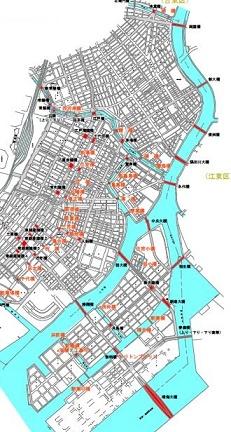
The Sumida River, which flows from the direction of Senju and Asakusa, crosses the Eitai Bridge and hits Okawabata on Tsukuda Island, where it is divided into the main stream of the Sumida River passing through Chuo-ohashi Bridge and the Sumida River school river heading to the left. You. Aioi Bridge is a bridge that spans the faction river that flows to the left. Tsukishima and Tsukuda (island) are now connected to Tsukiji and Fukagawa areas (Koto-ku) by many bridges and subways, but at the time Tsukishima was built in 1892, as the name suggests, this is the Sumida River Nakashu, and access was only ferry (Tsukuda, Tsukishima). Therefore, in 1903, Aioi Bridge was built as the first bridge connecting Fukagawa (Ecchujima) and Tsukuda / Tsukishima districts. 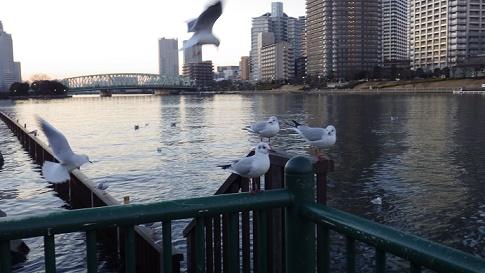 The name of Aioi Bridge is "The bridge relative to the upstream Eitai Bridge (Tokyo Metropolitan Bureau of Construction)" and "This bridge was a long and short bridge at the time of its founding, and is derived from two sets of "Aioi no Matsu" (wikipedia) ) ". Aioi Bridge consisted of two bridges (Aioi Ohashi: 147m, Aioi Kobashi: 53m) along Nakanoshima (Nakashu) floating in the school river. In 1980, the lower part of Aioi Kobashi (currently around the razor dike along Kiyosumi-dori) was reclaimed. Although it is connected to land, Nakanoshima still remains as a circular park with trees under Aioi Bridge Higashizume, and you can descend with stairs beside Kiyosumi-dori of the bridge. If you descend from the entrance on the upstream side (north side), there is a passage along the river, and you can go under the bridge to the other side. The name of Aioi Bridge is "The bridge relative to the upstream Eitai Bridge (Tokyo Metropolitan Bureau of Construction)" and "This bridge was a long and short bridge at the time of its founding, and is derived from two sets of "Aioi no Matsu" (wikipedia) ) ". Aioi Bridge consisted of two bridges (Aioi Ohashi: 147m, Aioi Kobashi: 53m) along Nakanoshima (Nakashu) floating in the school river. In 1980, the lower part of Aioi Kobashi (currently around the razor dike along Kiyosumi-dori) was reclaimed. Although it is connected to land, Nakanoshima still remains as a circular park with trees under Aioi Bridge Higashizume, and you can descend with stairs beside Kiyosumi-dori of the bridge. If you descend from the entrance on the upstream side (north side), there is a passage along the river, and you can go under the bridge to the other side. 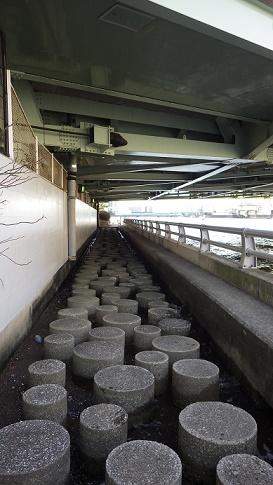 There are many parts of the Sumida River Terrace where proper sidewalks are maintained, but here you can feel like an adventure just because there are round stone pillars lined up. Going downstream (south side), it is a continuation of the park centered on lantern monuments. There are many parts of the Sumida River Terrace where proper sidewalks are maintained, but here you can feel like an adventure just because there are round stone pillars lined up. Going downstream (south side), it is a continuation of the park centered on lantern monuments.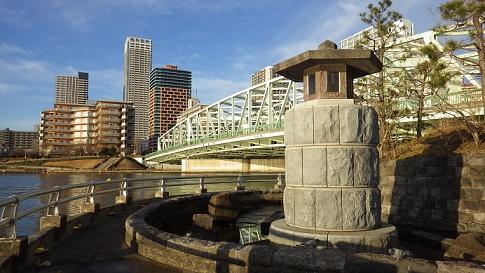
On the left is the Meiji Maru of Marine University, Toyosu Tower Condominiums and Harumi Bridge in front, and on the right you can see the whole view of Aioi Bridge. Aioi Bridge has a slightly sober impression compared to Eitai Bridge and Chuo-ohashi Bridge, which are lit up at night, but as shown in the photo, it is a bridge with a complicated truss structure that connects steel frames to "N" (or "X") characters. Of course, it is a beautiful bridge even at night, but its beauty seems to shine when it is lit by the sun. Although it is Koto-ku next door, Nakanoshima Park and Meiji Maru are said to have been selected as Koto Hakkei.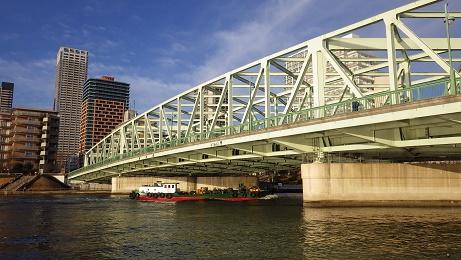
Nakanoshima Park has long been known as a famous spot for viewing the moon, but as you can see, it has a structure where the water of the Sumida River enters inside. Especially on the full moon night, tide level is high, and after high tide or a large ship passes, the water comes in by the wave, so be careful and enjoy it.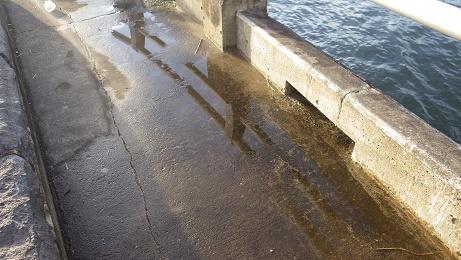
The Aioi Bridge itself is a bit plain, but the scenery seen from the bridge is superb. You can enjoy a wonderful night view such as a monument to light up the tower apartment in the Toyosu area and the Dock in Urban Dock LaLaport and Toyosu, as well as an airplane taking off from Haneda Airport to Tohoku and Hokkaido, and a new transportation Yurikamome running on Toyosu. You.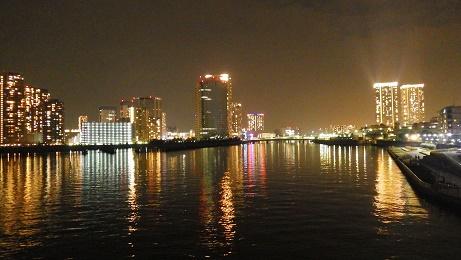
[Aioi Bridge]
Location :2-20 Tsukuda, Chuo-ku, 104-0051, Japan
(5-minute walk from Tsukishima on the Oedo Line and Yurakucho Line)
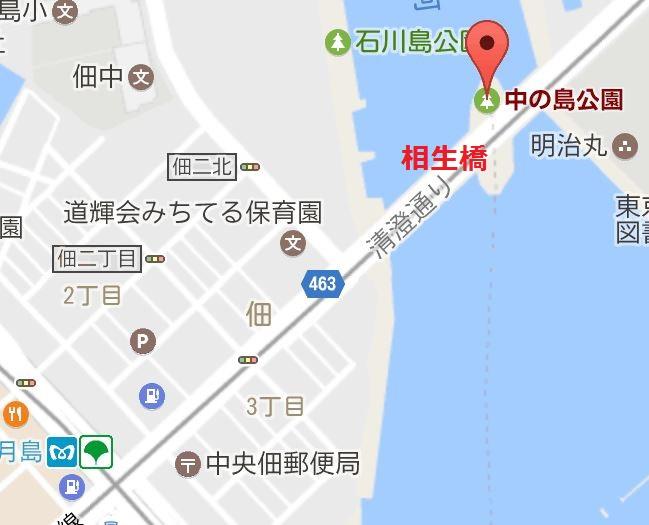
[The Rabbit of Tsukuda]
January 26, 2017 18:00
Finally, on the Sumida River Terrace near Aioi Bridge, where I introduced Iso brown-eared bulbul the other day! I found a male daurian redstart. Since I found daurian redstart female here near Aioi Bridge on November 3, last year, I have been looking forward to seeing no males.
Here's
 daurian redstart female daurian redstart female
 Male daurian redstart Male daurian redstart
Joubitaki is a winter bird that comes to Japan for wintering from the breeding grounds of Mongolia and northeastern China. Outside of the breeding season, there is a strong sense of territory, so unlike waterbird ducks where male and female act together and small bird hakusekirei, each male and female act independently.
 The male face is black, the head is silver, the chest is orange, the back is patterned like a cloak, and the wings are accented with white accents. If you look closely at the chic outfit in the distance, it is quite fashionable. Since you usually act alone, did you do your best in case of emergency? ? The male face is black, the head is silver, the chest is orange, the back is patterned like a cloak, and the wings are accented with white accents. If you look closely at the chic outfit in the distance, it is quite fashionable. Since you usually act alone, did you do your best in case of emergency? ?

It is difficult to observe and shoot small birds, but when I looked at them gently, they came nearby.

Take a walk on the Sumida River terrace where you can relax and see Mr. daurian redstart's stand in the calm winter sunshine.
[The Rabbit of Tsukuda]
January 18, 2017 14:00
Published on January 14, dimini ☆Here are some birds that can be seen near the "Sea House Ruins and Planting" where Mr. Cricket was guided.
In the bird book, Iso brown-eared bulbul is often classified as a blue bird.
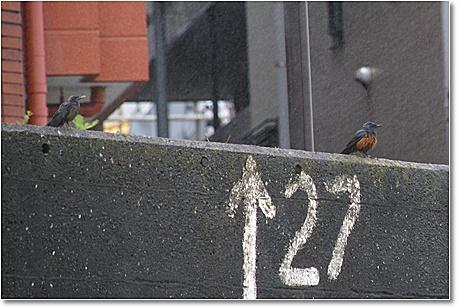 Male (right) and female (left) of Iso brown-eared bulbul Male (right) and female (left) of Iso brown-eared bulbul
There is a stone monument at the site of the Kaikaikan behind this dike, and there is a planting. If you cross the embankment, you will find the Sumida River Terrace at Aioi Bridge.
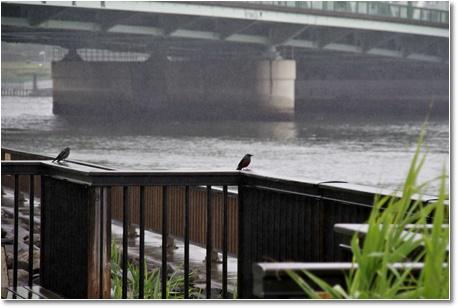
In Japan, the Iso brown-eared bulbul is a resident bird that can be seen all year round, and as its name suggests, it can be found on the cliffs and rocks of the coast and on the concrete dike.
On the other hand, in the world, it is widely distributed in Africa and Eurasian Continent, but it is a bird that lives in the rocky areas of alpine at an altitude of 2,000m to 4,000m.
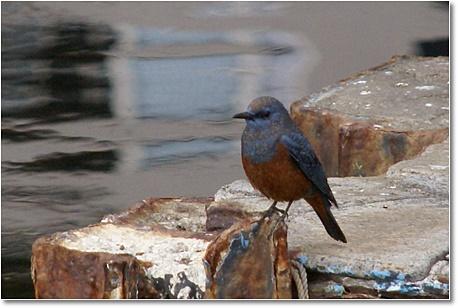 Male Male
When you encounter this blueness of a male, you will be surprised. The chest is dark brick. This color will be a protective color in rocky areas of mountains and seas. In the city, the rusted color of iron is the best match. Perhaps because of this, in recent years Japan, it has become inhabited in urban areas.
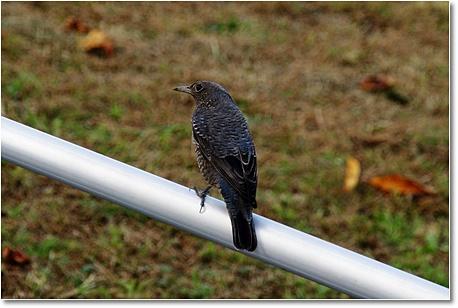 Female Female
Iso brown-eared bulbul lives powerfully in the land where literary people from the late Meiji and Taisho eras stayed and produced masterpieces.
[Sam]
January 16, 2017 09:00
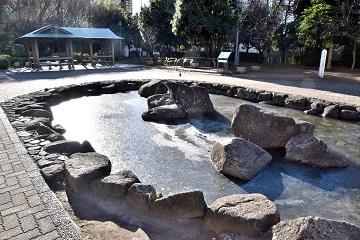 On January 12, the Tokyo Regional Meteorological Observatory reported "first ice". On January 12, the Tokyo Regional Meteorological Observatory reported "first ice".
The first ice observed every winter is "first ice", and that day is the first day of freezing.
Since December, Tokyo's minimum temperature of 0 ° C is counted for three days, but the first ice was not observed, and the lowest temperature dropped to 0 ° C for the first time in five days, and finally the first ice was observed for the fourth time.
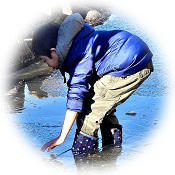 26 days later than normal, the second slowest record in the history of observation, after January 13 of last year. 26 days later than normal, the second slowest record in the history of observation, after January 13 of last year.
Next, on January 15th, the coldest coldest winter season flowed over Japan, and snow continued to fall over a wide area from northern Japan to the Sea of Japan side of West Japan due to the strong winter-type pressure pattern.
The lowest temperature in Tokyo this day was 2.3°C.
The pond at Tsukuda Park was also covered with ice.
But the children are fine.
He was breaking the ice and making a call.
[Dimini ☆ Cricket]
January 14, 2017 14:00
From Tsukuda 3-chome, Hatsumibashi intersection , head to Aioi Bridge on Kiyosumi-dori, and after walking about 150 meters, turn right and walk a little towards dike, right next to the dike, there is a stone monument and an explanation board at the site of Kaikaikan. , head to Aioi Bridge on Kiyosumi-dori, and after walking about 150 meters, turn right and walk a little towards dike, right next to the dike, there is a stone monument and an explanation board at the site of Kaikaikan.
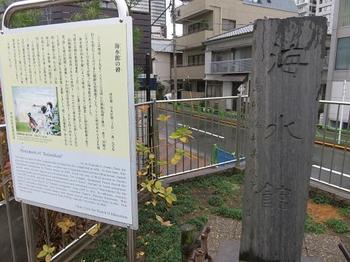
Kaikaikan is a Kappo cuisine Ryokan built by Hanzo Tsuboi in 1905. At that time, Tsukishima was a wind and glorious place facing Tokyo Bay. It was relocated here and opened as a ryokan and boarding house.
Because it was a quiet place, many literary artists used it as a place to write since the end of the Meiji era.
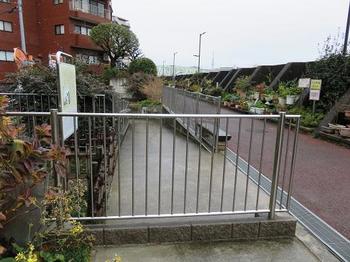
Toson Shimazaki wrote "Spring" here, Kaoru Osanai wrote "Okawabata", poet Isamu Yoshii created a songbook "Poison Utsugi", and Rofu Miki wrote a collection of poems "White Hand Hunts". It seems to have been compiled.
Unfortunately, the Kaikaikan was burned down in the Great Kanto Earthquake of 1923.
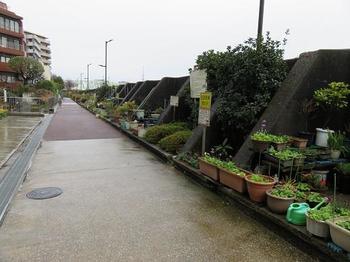
The area around the place where this monument is built has no remnant of the time, and it is difficult to imagine it as a place written by famous literary scholars from the Meiji era to the Taisho era while looking at the mountains of Boso from here.
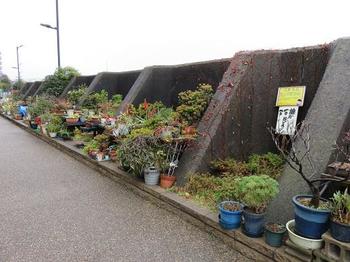
However, what I thought was interesting in a different sense was that a variety of flowers, bonsai, fruit trees, etc. were planted (grown) along the dike using the space divided by the reinforcement walls of dike approaching the stone monument.
Even though the remnants of those days disappeared, this song by Isamu Yoshii was perfect for this season and surrounding scenery.
     
The sea view of the winter and the Shintsukuda Kaisuikan are wabi-live (Isamu Yoshii).
     
[Sam]
January 14, 2017 12:00
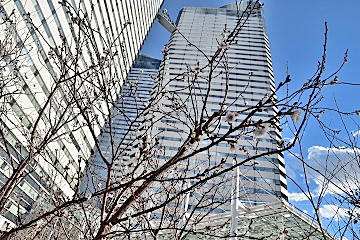 Harumi Triton Plaza 2F "i green Pocket Plaza Flower, Water, Tree" is an annual mini-garden guided tour to stroll around the park with the guidance of an exclusive gardener. Harumi Triton Plaza 2F "i green Pocket Plaza Flower, Water, Tree" is an annual mini-garden guided tour to stroll around the park with the guidance of an exclusive gardener.
This month was held on January 12th.
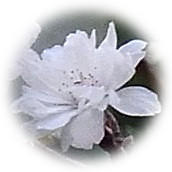 At North Triton Park, Jugatsuzakura is in full bloom. At North Triton Park, Jugatsuzakura is in full bloom.
This time it was the season of winter withering, so we took a walk on the theme of scent.
First of all, lemon, kinkan and tea tree in the slope garden along the Asashio Canal.
When you rub the leaves, you will have a unique scent.
In particular, lemon has a strong aroma similar to the fruit.
Next, Bra Shinoki and Ginbaika.
All of them have a unique subtle scent.
Yurinoki, Magnolia kobus, Mokuren, etc. also have a unique scent when tearing twigs.
By the way, the cross section of Hiiraginanten and Megi stems is yellow is also a new discovery.
In addition, while the number of flowers is small at this time, you can enjoy pansies, violas, kingyosotuynia, elemophilanibia, arissam, nemesia, etc., mainly on the flower terrace.
In addition to red color, you can also see pink gyoryubai.
This time it was also a plant walk with a new awareness.
    
From the left, tea tree, squirrel, elemophila, arism, nemesia
|
Links
|

 The name of Aioi Bridge is "The bridge relative to the upstream Eitai Bridge (Tokyo Metropolitan Bureau of Construction)" and "This bridge was a long and short bridge at the time of its founding, and is derived from two sets of "Aioi no Matsu" (wikipedia) ) ". Aioi Bridge consisted of two bridges (Aioi Ohashi: 147m, Aioi Kobashi: 53m) along Nakanoshima (Nakashu) floating in the school river. In 1980, the lower part of Aioi Kobashi (currently around the razor dike along Kiyosumi-dori) was reclaimed. Although it is connected to land, Nakanoshima still remains as a circular park with trees under Aioi Bridge Higashizume, and you can descend with stairs beside Kiyosumi-dori of the bridge. If you descend from the entrance on the upstream side (north side), there is a passage along the river, and you can go under the bridge to the other side.
The name of Aioi Bridge is "The bridge relative to the upstream Eitai Bridge (Tokyo Metropolitan Bureau of Construction)" and "This bridge was a long and short bridge at the time of its founding, and is derived from two sets of "Aioi no Matsu" (wikipedia) ) ". Aioi Bridge consisted of two bridges (Aioi Ohashi: 147m, Aioi Kobashi: 53m) along Nakanoshima (Nakashu) floating in the school river. In 1980, the lower part of Aioi Kobashi (currently around the razor dike along Kiyosumi-dori) was reclaimed. Although it is connected to land, Nakanoshima still remains as a circular park with trees under Aioi Bridge Higashizume, and you can descend with stairs beside Kiyosumi-dori of the bridge. If you descend from the entrance on the upstream side (north side), there is a passage along the river, and you can go under the bridge to the other side.  There are many parts of the Sumida River Terrace where proper sidewalks are maintained, but here you can feel like an adventure just because there are round stone pillars lined up. Going downstream (south side), it is a continuation of the park centered on lantern monuments.
There are many parts of the Sumida River Terrace where proper sidewalks are maintained, but here you can feel like an adventure just because there are round stone pillars lined up. Going downstream (south side), it is a continuation of the park centered on lantern monuments.




 daurian redstart female
daurian redstart female  Male daurian redstart
Male daurian redstart The male face is black, the head is silver, the chest is orange, the back is patterned like a cloak, and the wings are accented with white accents. If you look closely at the chic outfit in the distance, it is quite fashionable. Since you usually act alone, did you do your best in case of emergency? ?
The male face is black, the head is silver, the chest is orange, the back is patterned like a cloak, and the wings are accented with white accents. If you look closely at the chic outfit in the distance, it is quite fashionable. Since you usually act alone, did you do your best in case of emergency? ?

 Male (right) and female (left) of Iso brown-eared bulbul
Male (right) and female (left) of Iso brown-eared bulbul 
 Male
Male  Female
Female On January 12, the Tokyo Regional Meteorological Observatory reported "first ice".
On January 12, the Tokyo Regional Meteorological Observatory reported "first ice". 26 days later than normal, the second slowest record in the history of observation, after January 13 of last year.
26 days later than normal, the second slowest record in the history of observation, after January 13 of last year.



 Harumi Triton Plaza 2F "i green Pocket Plaza Flower, Water, Tree" is an annual mini-garden guided tour to stroll around the park with the guidance of an exclusive gardener.
Harumi Triton Plaza 2F "i green Pocket Plaza Flower, Water, Tree" is an annual mini-garden guided tour to stroll around the park with the guidance of an exclusive gardener. At North Triton Park, Jugatsuzakura is in full bloom.
At North Triton Park, Jugatsuzakura is in full bloom.





